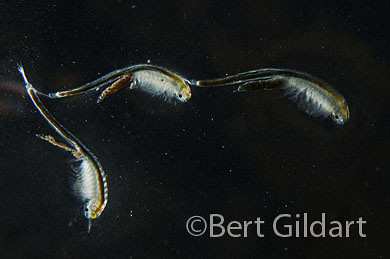Rain at Anza Borrego Desert State Park Works Magic for Fairy Shrimp
©Bert Gildart: Once every five to six years, California’s Anza Borrego Desert State Park is deluged with rain water and if it pools, a miracle occurs. Embedded in the playa of Ancient Lake Borrego, the lake from which Clark Lake (also dry) eventually derived, tiny crustaceans break free of their cysts. Specifically, the cysts have enabled early stages of the tiny fairy shrimp to survive desiccating winds and the summer temperatures that often exceed 120 degree Fahrenheit.
That’s what’s has recently happened at this 50,000 year old lake bed. Rains have been exceptional, particularly in recent months. And now, with yet another downpour last week, the shriveled and dried up surface that until recently comprised Lake Clark, has soaked up enough moisture so that the phenomena has occurred. Rains have softened the cysts; and they have erupted; and you can now see the half-inch-long fairy shrimp powering along the edge of this ancient lake now slightly watered.
ADAPTATIONS TO LIFE
Though difficult to see, fairy shrimp perform all the functions of life we consider normal, they but do so with structures that are certainly different from those with which we are familiar. They have a thorax which consists of 11 segments, and leaflike legs. And here is where you find the breathing organs as well as lobes for paddling. You’ll see the shrimp if you take the time to study the water’s edge, and though they won’t be seting records for speed, they sure can move.
Look even closer and if one of these tiny creatures stops you might even see the animal’s two sets of antennae. One is extra long and it is used for grasping females during mating. Later, eggs fall to the surface mud where they might sink slightly and then develop to an early embryo stage, remaining dormant then until the next wet season. Here at Clark Lake that could be another five years down the road when heavy rains fall once again. At that time, eggs will hatch about 30 hours after rains fill the pools.
ENDANGERED CREATURES
Though the United States hosts a number of different species of fairy shrimp, five species are endangered. Declines are the result of habitat loss from agricultural and urban development, alteration of wetland by draining – and from off-road vehicle activity.
CLICK TO SEE ENLARGED IMAGE AND FOR EXTENDED CAPTION. L to R: Ancient Clark Lake, fairy shrimp, bicycling to Clark Lake, proof that fines are not sufficient to curtail activities of a certain segment of society.
In Anza Borrego off-road use is tolerated in specific areas, but a certain segment of the group flagrantly ignore signs. Their actions serve to give all in the group a bad name, which is unfortunate, as most in are law abiding. Sadly there was much evidence this past week of such activity immediately adjacent to a posted sign at Clark Lake. (See photos of JUST ONE example.)
Fairy shrimp serve as an important cog in the food chain, providing sustenance for a variety of shore birds. Photographing the species requires specialized equipment and much patience, but I enjoy looking at them as they remind me of the extraordinary adaptations life has made to endure under the most capricious of circumstances.
___________
THIS TIME TWO YEARS AGO:
*Spring Awakening Death Valley
ADS FROM GOOGLE AND AMAZON AUGMENT OUR TRAVELS:






